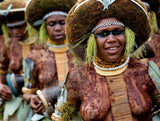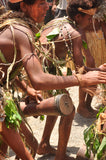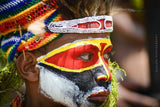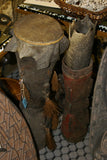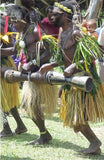Rare One of a Kind Bigman Tribal Older Wood Kundu Hourglass Hand Held Drum, Hand Carved Percussion Instrument with Dried Palm Tassels decorations, original monitor skin, Huon Gulf, Eastern New Guinea 1980's, Melanesia 42A6
Unique original Vintage hand carved Wooden hourglass Kundu drum from the Huon Gulf region, Eastern New Guinea, area named after French explorer Jean-Michel Huon de Kermadec. Huon Gulf is a part of the Solomon Sea.
Collected in the 1980's, but older.
This very long Hourglass Hand Held Drum was created out of one solid piece of wood and hand carved by a tribesman: This is a unique older piece with the original monitor skin on top (thympan) used during initiations, festivities and sing-sings and a rare and unusual collector item from a very remote region of P.N.G
Original Musical Instrument. Complete with hand carved wood motifs and dried palm tree strips tassel decorations.
Item 42A6 in our inventory.
Size: 28 1/2" tall x 7" diameter
COMES WITH ITS OWN MONITOR SKIN. IT IS HARD TO FIND THEM COMPLETE LIKE THIS!
Previously part of our private collection
(seen on most of the photos except for the ones taken in the field)
This is a valuable older piece collected on the premises around 30 years ago, it was played a lot back then as you can see from the patina on the handle. Great condition. Estimated to be Mid 1900's.
PLEASE INSPECT PICTURES CAREFULLY TO BE SATISFIED, THEY TELL BETTER THAN WORDS.
The kundu is a single-head hourglass drum of Papua New Guinea. “Kundu” is a generic name for such drums, but each of the hundreds of tribal groups on the island of New Guinea and many of its surrounding islands has a local name for this drum type (for example, see the entry for the tifa of the Asmat people). Based on morphological and decorative clues, the kundu very likely originated amongst the Iatmul people of the Middle Sepik River region of Papua New Guinea. A number of similar Iatmul drums can be found in museum collections around the world and some of these are named kwangu (or kangu or kwang-gu), which would appear to be the term for such kundu drums in the language of the Iatmul.
The shell of this kundu is carved from a solid block of hardwood using tools and fire to produce its tubular hourglass form and thin walls.
If seated, the kundu player places the drum across his lap and strikes the drumhead with the open palm of the hand nearest the drumhead. If standing, the drum can either be held with one hand by its handle or cradled horizontally with one arm across the player’s chest, leaving the free hand to strike the head. In general, as well as amongst the Iatmul, a beater or beaters are not used to sound the drum. Tuning is accomplished by heating the head over fire and by applying small black pellets of beeswax, used for fine tuning the sound quality of the drum, attached in a circular pattern usually around the center of the head.
The origin of hourglass drums in Oceania is lost to history. It can at best be pointed out that this form of drum is distributed primarily in Melanesia (Papua New Guinea and the islands to its north) and Micronesia (primarily the eastern island groups, including the Marshalls). King, McLean, and Montagu (2014, p. 715) imply that, in Oceania, this form of drum spread from Melanesian cultures to Micronesian ones. It does not appear possible at this time to link the evolution and spread of these Oceanic hourglass drums to those of other regions of the world—primarily Africa.
All our collector and rare items come with pages and pages of research about provenance, and with history of the tribes and photos as well, depending on item and whenever possible. When shipping internationally, we group ship multiple purchases to save you money, and find the best rates available. If you have any questions or want to see research conducted on this piece and photos of tribes, let us know.







































